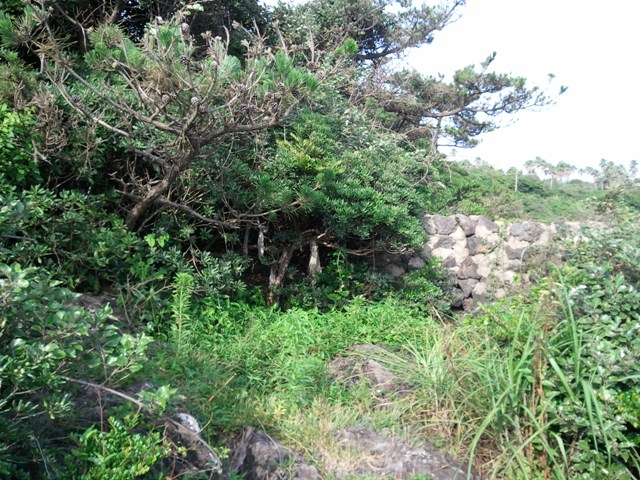| |
 |
|
| ▲ Tosan site of maiden deaths. Photo by Anne Hilty |
Jeju has a strong legacy of snake worship.
A matrilineal tradition passed from mother to daughter, found throughout the island but strongest in the eastern region, it is a reverence shared by many of the world's people, in cultures of India, Africa, Australia, the Americas, Europe, the Middle East, and other regions of Asia – including the Korean mainland.
Indeed, one of Jeju's principle snake goddesses, Tosan Halmang who is the patron deity of Tosan Village, was thought to have come here by ship from Seoul or, as another version would have it, from Naju in Jeolla Province, under the jurisdiction of which Jeju belonged before gaining its own provincial status.
Tosan Halmang's story begins with two young maidens washing laundry in a riverbed, the mouth of which opens to the sea.
The snake goddess meanwhile, having taken up residence in the village not long before and angered by the people's inability to recognize and thus worship her, determined to bring about a catastrophe that included sacrifice. This, in conjunction with similar myths, notably the Chilseong Bonpuri, depicts Jeju people's traditional belief that snake gods came from elsewhere and were a threat unless they were worshiped.
Raiding Japanese pirates entered the area, a common thread in Jeju history with its stone structures for guarding against same, including lookout points, fire signal towers, and fortresses. Spying the girls, they raped and killed them. Upon their death, the goddess and her female servant entered them as spirits and the girls were instantly transformed into snakes, which scared off the pirates.
The pirates were not to escape, however. Tosan Halmang then called upon her lover, Gaeroyukseo, to strike the pirates dead by sinking their ship. Gaeroyukseo was a well-established god throughout the Seongsan region; the people failed to worship Tosan Halmang not only because they didn't recognize her, but also because of their dedication to Gaeroyukseo.
A shrine was erected by the villagers in memory of the two girls who had disappeared and were presumed dead – their bodies undiscovered because of their transformation.
A year later, the brother of one of the girls married one of his sister's friends. His bride, however, soon exhibited signs of mental illness, and the shaman was called to perform a 14-day 'keun-gut' or great rite. The shaman communicated with the spirit of the groom's sister to bring consolation; on the second day of the ritual, to everyone's shock, the spirit of the second deceased girl arrived and through her, Tosan Halmang – the existence of whom the villagers were still unaware – began speaking.
The goddess demanded the dead girl's wedding clothes as a gift, saying that, although she had arranged the catastrophe because of the villagers' denial of her, she too had 'died' that day by entering and becoming trapped in the dead girl's transformed body. Upon receiving this gift, the goddess was released from her trapped form and became a snake in her own right, indicating the regeneration for which snakes are revered. Villagers worshiped her from that time forward.
The snake is thought to bring prosperity if worshiped, but disaster if denied, a powerful figure.
Snake worship on Jeju has always belonged primarily to the women, a matrilineal heritage. Daughters followed the religion of their mothers; if they married someone from a different religion, they did not convert to that of their husbands. Females born in the Year of the Snake were considered especially fortuitous; An Chilseong and Pat Chilseong, goddesses of granaries, were worshiped in the home.
| |
 |
|
| ▲ Tosan shrine to lovers. Photo by Anne Hilty |
Tosan Halmang, and indeed all snake deities, are potent images in Jeju,revered for their seeming abilities of regeneration associated with reincarnation, of shedding their skin and obtaining “new life” or a new beginning which signifies prosperity, abundance, youth, and healing.
However, snake worship became corrupted over time.
There is a Gimnyeong snake myth which involves a giant snake living in a cave, terrorizing the villagers and requiring virgin sacrifice, the defeat of which comes at the hand of the young magistrate sent from the mainland to govern Jeju. This myth is considered a distortion of Jeju's shamanist snake worship by a dynasty heavily vested not only in elevating Confucianism through suppression of both Shamanism and Buddhism, but also in emphasizing the supremacy of mainland governance – and, of men over women.
The yeodeuret-dang, a shrine for worship on the days of the month containing an “8” and once the place for worship of snake deities in particular, is now reconceptualized as a shrine to “shape-shifters” or gods who could change their shape as needed – including, but not limited to, that of a snake. These shrines have also at times been associated with “greed” rather than prosperity, and people have been known to hide their worship.
Although evidence of snake worship is found throughout Jeju, it was exceptionally strong in the east, and it is said that men from the west often refused to marry women from the east, fearing the snake spirit that would accompany her. Tosan villagers who came to Jeju City often found that they couldn't obtain housing; Jeju City students would typically refuse to sit next to Tosan children in school.
Some discrimination against Tosan exists to this day. Perhaps because of this, the shrine to Tosan Halmang has been removed, and a village center built in its place. A secondary shrine, however, by the seashore at a site considered the meeting place for Tosan Halmang and her lover Gaeroyukseo, still exists and is said to be visited by couples, though it is in grave disrepair.
Today, the image of the snake is tainted by the Christian view of the creature as a symbol of evil. A few years ago, MBC broadcast a summer program based on the Tosan snake goddess – a 'ghost story' meant to 'chill' its viewers in the summer heat. What once was worshiped, it seems, is now only feared.
–
Kim Soonie, Jeju native, is a mythologist and Jeju representative of the nation's Cultural Heritage Administration. Anne Hilty is a cultural health psychologist from New York who now makes Jeju Island her home. Interpretation / translation was provided by Han Youngsook, Jeju native and instructor at Jeju National University.
|





















